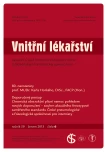Up‑ to‑ day trends in insulin therapy
Authors:
A. Adamíková; J. Rybka
Authors‘ workplace:
Diabetologické centrum, koordinátorka MU Dr. Alena Adamíková, Ph. D., Interní klinika IPVZ Krajské nemocnice T. Bati, a. s., Zlín, přednosta prim. MU Dr. Jiří Latta
Published in:
Vnitř Lék 2013; 59(6): 440-443
Category:
80th birthday prof. MUDr. Karla Horkého, DrSc., FACP (Hon.)
Overview
Patients with type 2 diabetes mellitus have a double risk of development of cardiovascular diseases than patients without diabetes. Two thirds of patients with type 2 diabetes mellitus can die from heart attack or a cerebrovascular accident if it is not possible to influence these risks by procedures such as decreasing the blood pressure, cholesterol level, glycemia and to stop smoking. The recommendations of ADA/ EASD for therapy of type 2 diabetes mellitus emphasizes that the therapy should be conducted in such a manner as to decrease the risk of cardiovascular complications and undesirable effects, primarily hypoglycemic events. A whole line of clinical studies, e. g. DCCT‑ EDIC, UKPDS have documented the importance of intensive insulin therapy for achievement of normoglycemia, decreasing risk of microangiopathic complications and in follow‑up observation, also decreasing of cardiovascular risk. An ORIGIN study with insulin glargine documented the safety of therapy of long‑acting insulin analog and also reduction of development of new diabetes from pre‑diabetes. Insulin therapy with respect to the positive outcomes of study with insulin analogs moved up to the second line in algorithm therapy, immediately after metformin therapy and change of life style.
Key words:
insulin analogs – type 2 diabetes mellitus – hypoglycemia – cardiovascular diseases
Sources
1. Rendell M. The path to approval of new drugs for diabetes. Expert Opin Drug Saf 2013; 12: 195– 207.
2. UKPDS Group. Intensive blood glucose control with sulphonylureas or insulin compared with conventional treatment and risk of complications in patients with type 2 diabetes. Lancet 1998; 352: 837– 853.
3. Holman RR, Paul SK, Bethel MA et al. 10‑year follow‑up of intensive glucose control in type 2 diabetes. N Engl J Med 2008; 359: 1577– 1589.
4. The Action to Control Cardiovascular Risk in Diabetes Study Group. Effects of intensive glucose lowering in type 2 diabetes. N Engl J Med 2008; 358: 2545– 2559.
5. The ADVANCE Collaborative Group. Intensive blood glucose control and vascular outcomes in patients with type 2 diabetes. N Engl J Med 2008; 358: 2560– 2572.
6. Duckworth W, Abraira C, Moritz T et al. Glucose control and vascular complications in veterans with type 2 diabetes. N Engl J Med 2009; 360: 129– 139. Erratum in: N Engl J Med 2009; 361: 1028.
7. Kjems LL, Kirby BM, Welsd M et al. Decreasein beta‑cell mass leads to impaired pulsatile insulin secretion, reduced postprandial hepatic insulin clearance, and relative hyperglucagonemia in the minipig. Diabetes 2001; 50: 2001– 2012.
8. Chon S, Oh S, Kim SW et al. The effect of early insulin therapy on pancreatic beta‑cell function and long‑term glycemic control in newly diagnosed type 2 diabetic patients. Korean J Intern Med 2010; 25: 273– 281.
9. Inzucchi SE, Bergenstal RM, Buse JB et al. Management of hyperglycemia in type 2 diabetes: a patient‑ centered approach. Position statement of the American Diabetes Association (ADA) and the European Association fot the Study of Diabetes (EASD). Diabetes Care 2012; 35: 1364– 1379.
10. Fonseca V, Gill J, Zhou R et al. An analysis of early insulin glargine added to metformin with or without sulfonylurea: impact on glycaemic control and hypoglycaemia. Diab Obes Metab 2011; 13: 814– 822.
11. Owens D, Dain MP, Landgraf W. Early onset of glycaemic improvements after insulin initiation with glargine in T2DM patients uncontrolled with OADS. CODHy 2012 abstrakt 113 [online] [cit. 06- 02- 2013]. Available from: www.codhy.com/ 2012/ abstract_list.aspx.
12. Gerstein HC, Bosch J, Dagenais GR et al. ORIGIN Trial Investigators. Basal insulin and cardiovascular and other outcomes in dysglycemia. N Engl J Med 2012; 367: 319– 328.
13. Lonn EM, Bosch J, Diaz R et al. Effect of insulin glargine and n‑ 3FA on carotid intima‑ media thickness in people with dysglycemia at high risk for cardiovascular events. Diabetes Care 2013; 5: 1– 9.
14. Bergenstal RM, Bailey C, Kendall DM. Type 2 diabetes: assessing the relative risks and benefits of glucose-lowering medications. Am J Med 2010; 123: e9–e18.
15. Zinman B, Philis‑ Tsimikas A, Handelsman Yet al. Effect of insulin degludec on glycaemic control and nocturnal hypoglycaemia compared with insulin glargine: a 1‑year trial in insulin‑-naive patients with type 2 diabetes. Diabetologia 2012; 55 (Suppl 1): S22.
16. DeVries JH, Ratner RE, Bode BW et al. Two phase 3 trial of three‑ times weekly insulin degludec versus once‑ daily insulin glargine in insulin‑naïve people with type 2 diabetes. Diabetologia 2012; 55 (Suppl 1): S21.
17. Rosenstock J, DeVries JH, Seufert J et al. A new type 2 diabetes treatment paradigm: sequential addition of liraglutide to metformin and then basal insulin detemir. Diabetes 2011; 60 (Suppl 1): A76.
18. Rosenstock J, Forst T, Aronson R et al. Once‑ daily lixisenatide added on to consistently titrated insulin glargine plus oral agents in type 2diabetes: the GetGoal‑ Duo 1 study. Diabetologia 2012; 55 (Suppl 1): S333.
19. Bowering K, Reed VA, Felicio J et al. A study comparing insulin lispro mix 25 with glargine plus lispro therapy in patients with type 2 diabetes who have inadequate glycaemic control on oral antihyperglycaemic medication: results of the PARADIGM study. Diabet Med 2012; 29: e263– e272.
Labels
Diabetology Endocrinology Internal medicineArticle was published in
Internal Medicine

2013 Issue 6
Most read in this issue
- Differential diagnosis and treatment of hyponatremia
- Impact of pregnancy on pituitary disorders
- Diuretics in monotherapy and in combination with other diuretics and non‑diuretics in the treatment of hypertension
- The environmental estrogen bisphenol A and its effects on the human organism
